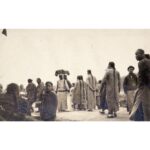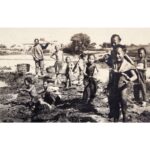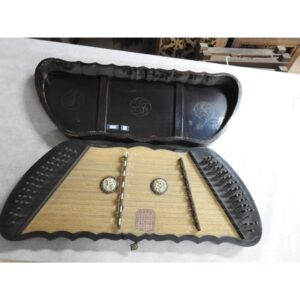Photography Street Scene
A black-and-white photograph showing groups of onlookers and passers-by on the street. Two Manchu women of a higher social class are walking in the centre, with men in various uniforms standing behind them on the right. Their padded clothing suggests that the scene was shot in winter. The long braided chignon bianzi 辮子 worn by some of the men is a traditional Manchu male hairstyle that became mandatory for all male subjects during the Qing Dynasty (1644–1912). Just as wearing this hairstyle indicated allegiance to the rule of the Manchu royal family, cutting off the male pigtail became part of a general rebellion against “foreign” rulers at the end of the Qing Dynasty. The man facing the lens, wearing a hat, is wearing a traditional Qing Dynasty male garment – a five-button breast coat called a magua 馬褂. The man in the lower right-hand corner wearing a round cap is probably a member of a Muslim minority.
The photograph is the 157th of 449 photographs of ... more
A black-and-white photograph showing groups of onlookers and passers-by on the street. Two Manchu women of a higher social class are walking in the centre, with men in various uniforms standing behind them on the right. Their padded clothing suggests that the scene was shot in winter. The long braided chignon bianzi 辮子 worn by some of the men is a traditional Manchu male hairstyle that became mandatory for all male subjects during the Qing Dynasty (1644–1912). Just as wearing this hairstyle indicated allegiance to the rule of the Manchu royal family, cutting off the male pigtail became part of a general rebellion against “foreign” rulers at the end of the Qing Dynasty. The man facing the lens, wearing a hat, is wearing a traditional Qing Dynasty male garment – a five-button breast coat called a magua 馬褂. The man in the lower right-hand corner wearing a round cap is probably a member of a Muslim minority.
The photograph is the 157th of 449 photographs of Beijing and its surroundings in the album of Ivan Skušek Jr., purchased during his stay in Beijing (1914–1920). In the handwritten inventory of the album, the photograph is referred to as Strassenbild. (DZ, MV)





































Do you have a comment or additional information about the subject?